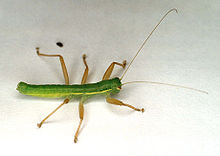Mantophasmatidae
| Gladiators Temporal range: Jurassic–Recent
| |
|---|---|

| |
| Mantophasma zephyra | |
| Scientific classification | |
| Kingdom: | |
| Phylum: | |
| Class: | |
| Subclass: | |
| Infraclass: | |
| Superorder: | |
| Order: | Notoptera
|
| Suborder: | Mantophasmatodea
|
| Family: | Mantophasmatidae
|
The insect family Mantophasmatidae is the sole family in its order. It is a group of African carnivorous insects discovered in 2002.[1] The most common vernacular name for this order is gladiators, but it is not well known under any name.
Their modern centre of endemism is western South Africa and Namibia, although a relict population and Eocene fossils suggest a wider ancient distribution.
Members of the order are wingless even as adults, making them relatively difficult to identify. They resemble a mix between praying mantids and phasmids. Molecular evidence indicates that they are most closely related to a family known as the Grylloblattidae.[2]
The mantophasmids were originally described from old museum specimens that found in Namibia (Mantophasma zephyra) and Tanzania (M. subsolana), and from a 45-million-year-old specimen of Baltic amber (Raptophasma kerneggeri).
The most recent classification recognizes numerous genera, including fossils.[3]
References[change | change source]
- ↑ Primack, Richard B. (2006). Essentials of conservation biology (4th ed.). Sinauer Associates, Inc. p. 62. ISBN 978-0-87893-720-2.
- ↑ Cameron S.L; Barker S.C. & Whiting M.F. (2006). "Mitochondrial genomics and the new insect order Mantophasmatodea". Molecular Phylogenetics and Evolution. 38 (1): 274–279. doi:10.1016/j.ympev.2005.09.020. PMID 16321547.
{{cite journal}}: CS1 maint: multiple names: authors list (link) - ↑ Arill, A. & M. Engel 2006. Rock crawlers in Baltic amber (Notoptera: Mantophasmatodea). American Museum Novitates 3539:1-10[1] Archived 2008-12-17 at the Wayback Machine
